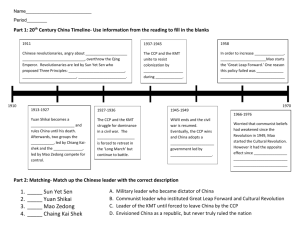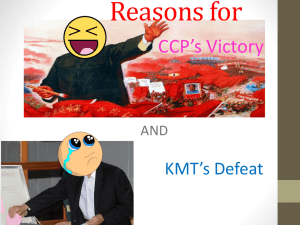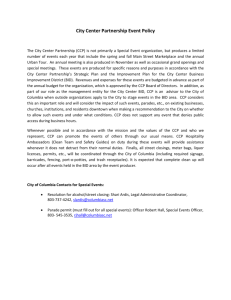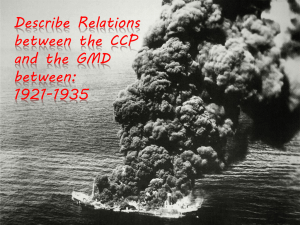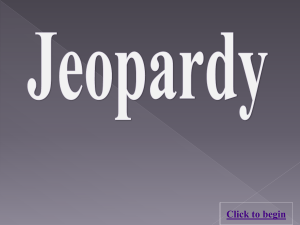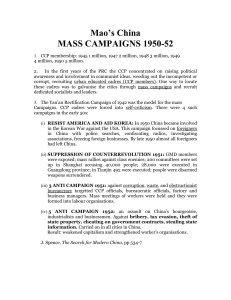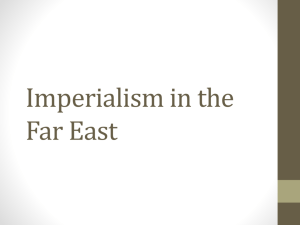China in the 20th Century - aise
advertisement
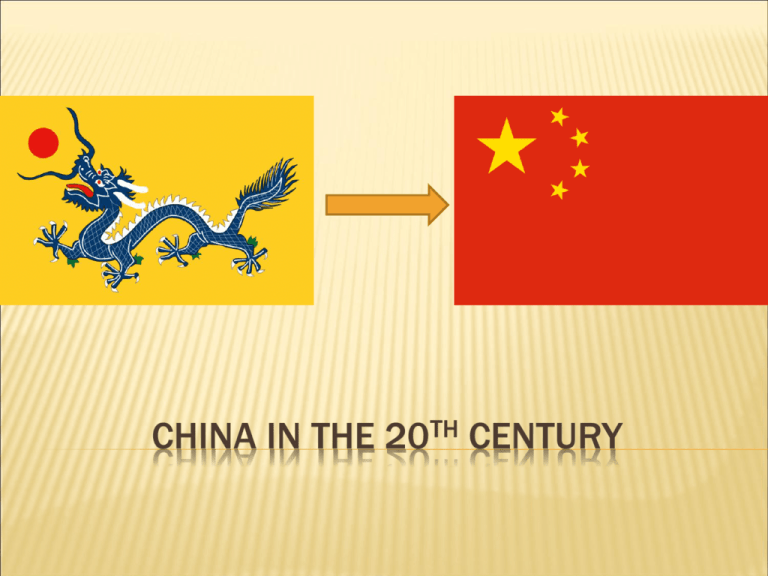
CHINA IN THE 20TH CENTURY A French political cartoon of 1899 represents the carving of China into spheres of influence TWILIGHT OF THE QING DYNASTY Boxer Rebellion left no doubt about need for reform Empress Cixi accepted reforms New education system based on Western model Provincial & national legislatures Not allowed to pass laws Reforms did not improve economic conditions Emerging middle class impatient with pace of reform Empress Cixi chills out at the Summer Palace SUN YAT-SEN Republican & anti-Qing activist Educated in US and lived in Japan Founded Chinese Revolutionary Alliance in 1905 Popular with overseas Chinese, reformers, and young military officers Three Principles of the People: Nationalism: overthrow the Manchu Dynasty and end foreign hegemony Democracy: establish an elected republican government People’s livelihood: implement a mild form of socialism to aid the common people Sun Yat-sen celebration Tiananmen Square, Beijing, 2005 1908 - Empress Cixi died - Pu Yi became emperor at age 3 XINHAI REVOLUTION (1911-12) October 1911: discontented army units in Wuhan overthrew the local govt after an anti-Qing plot was discovered Similar uprisings from army units and Revolutionary Alliance groups followed throughout China 15 of 24 provinces declared independence January 1912: Sun Yat-sen elected first President of the Republic of China by independent provinces General Yuan Shikai joined the rebellion and turned on the Qing govt February 1912: Emperor Puyi abdicated Revolutionaries hang flags in the streets of Shanghai during the revolution A poster commemorating Yuan Shikai and Sun Yat-sen Long live the Republic! EARLY REPUBLIC Republic of China was established in Nanjing on January 1, 1912 with Sun Yat-sen as Provisional President All effective power, however, was possessed by General Yuan Shikai in Beijing To prevent civil war Sun Yat-sen resigned in favor of Yuan Shikai in March 1912 Yuan’s military power overshadowed that of political parties and parliament Yuan became increasingly dictatorial In August 1912 the anti-Yuan Kuomintang won a majority of seats in parliament REBELLION & CHAOS Relations between Yuan and the Kuomintang deteriorated in 191213 In July 1913 7 southern provinces rebelled Rebellion was swiftly suppressed by Yuan and a compliant parliament elected him President Most countries formally recognized Yuan’s govt Yuan agreed to autonomy for Outer Mongolia and Tibet and special privileges for Russia and Britain CHINA UNDER YUAN Small bandit armies wreaked havoc throughout the provinces In 1914 Yuan substantially enlarged the powers of the President Political parties, provincial leaders, and the public grew steadily more disenchanted with Yuan In December 1915 Yuan declared himself emperor of China Several southern provinces declared independence In March 1916 Yuan abdicated as emperor He died in June 1916 21 DEMANDS In 1914 China declared war on German and seized property In 1915 Japan issued the 21 Demands to the Yuan govt Japanese economic control in Shandong, Manchuria & Fujian Yuan to appoint Japanese advisors to key posts Would essentially make China a protectorate of Japan China rejected most demands but accept Japanese control over parts of Shandong & Manchuria Concessions were extremely unpopular with the public but a sign of the govt’s weakness WARLORD ERA (1916-27) After Yuan’s death in 1916 no new national govt was able to assert control over the provinces Regional warlords fought each other for control in a series of constantly shifting alliances In 1917 Sun Yat-sen became President of a rival govt in southern China Both northern and southern govts were highly reliant on regional warlords and were unsuccessful in unifying the country 1916-28: China was essentially divided among warlords constantly fighting one another MAY 4TH MOVEMENT In 1917 China declared war on Germany in hopes of recovering Shandong from Japan In May1919 the Great Powers at Versailles decided to allow Japan to retain Shandong This sparked massive demonstrations throughout China against Japan and the West China refused to sign the Treaty of Versailles Students, intellectuals and reformers became disillusioned with the West, democracy and liberalism The May 4th Movement defined China’s aspirations as nationalistic and anti-Western ECONOMIC CHANGES European & American traders brought changes to China’s coastal cities Growth of industry Rise in imports and exports China increasingly linked to world market Improved transportation and communications systems Improved banking system New crops raised food production Negative impacts New factories destroyed existing local industries Profits went to foreigners SHANGHAI IN 1920 CULTURAL CHANGES 35,000 foreigners lived in Shanghai and shared their culture with the new Chinese urban middle class Western literature, art, clothing, and music became popular Some reformers condemned Chinese traditions as barbaric Young people were drawn to Western ideas Individualism Women’s rights These cultural changes hardly reached most Chinese in rural areas Cigarette advertisements CHINESE COMMUNIST PARTY Founded in 1921 in Shanghai Most Chinese communists believed that the revolution must come from the tiny urban proletariat Mao Zedong believed that the peasantry must be the source of revolution Party remained very small and weak during 1920s Comintern agents were sent by Moscow to help organize the CCP In 1923 they orchestrated a United Front with the Kuomintang (KMT) KUOMINTANG Largest opposition party during the 1920s Led by Sun-Yatsen until his death in 1925 Advised by the Comintern to ally with the CCP Chiang Kai-shek was an ally of Sun Yat-sen and rose through the ranks to become the head of the Whampoa Military Academy Was quickly seen as Sun’s successor Had a more right-wing and nationalist set of beliefs than Sun CHIANG CONSOLIDATES POWER (1925-27) In 1925 Chiang’s National Revolutionary Army (KMT) embarked on the “Northern Expedition” to defeat warlords and unify China By 1926 half of China was under KMT control Chiang became increasingly suspicious of the loyalty of the CCP to the alliance In April 1927 Chiang initiated the Shanghai Massacre in which most of the CCP leadership was killed or arrested The alliance was destroyed and the CCP was severely weakened Chiang was now undisputed leader of the KMT KMT CONSOLIDATES POWER By 1928 KMT controlled most of China and moved capital to Nanjing Recognized by foreign govts 1928-36: time of relative stability Nationalist govt initiated reforms Legal and penal systems Banking and currency Railroads and highways Hospitals and schools Industry and agriculture Reduced foreign concessions Newspapers and radio proliferated Promoted women’s rights KMT reduced political freedom and opposition movements Throughout much of China KMT still heavily relied on cooperation of regional warlords and generals China received significant industrial and military aid from China from 1928-36 CIVIL WAR (1927-34) Shanghai Massacre (1927) is start of the Chinese Civil War Remnants of the CCP flee to rural areas of southern China and work to foment peasant rebellions All revolts are small and quickly crushed by KMT Mao creates the Jiangxi Soviet based on communist principles 1930-34 KMT repeatedly launches unsuccessful raids to crush it KMT encirclement in 1934 forces CCP to flee Jiangxi and trek north to unite with other CCP forces LONG MARCH (1934-35) 90,000 CCP members and families trek west and north over 12,500 km to unite with CCP group in Yenan province Arrive in Yenan after 1 year KMT and warlords attack Red Army all along the route Extreme cold, hunger and fatigue take heavy toll Only 8,000 survived the trek During this ordeal Mao shows good judgment and consolidates his position as leader of the CCP By 1936 the CCP has been all but annihilated and quarantined within China by the KMT MANCHURIAN INCIDENT (1931) In 1931 Japan invades Manchuria and establishes puppet state of Manchukuo Motivated by desire for raw materials and industry League of Nations fails to respond effectively 1932-36 Japanese forces slowly extend control into coastal provinces KMT preoccupied with war against CCP Public is increasingly disillusioned with Nationalists’ priorities, corruption, incompetence, and Westernism SECOND SINO-JAPANESE WAR (1937-45) 1936: Chiang is kidnapped and forced to ally with the CCP in order to fight the Japanese as the term of his release 1937: skirmishes at the Marco Polo Bridge near Beijing lead to full-scale warfare between China and Japan KMT and CCP declare the Second United Front Japanese army rapidly advances into coastal China and captures Nanjing Rape of Nanjing KMT retreats and continues the war from central China KMT army marches through Burma during the Second Sino-Japanese War THE CCP IN YENAN (1937-45) Second United Front gives CCP a chance to consolidate hold in Yenan and grow CCP allows KMT to do bulk of fighting against Japan From 1940 KMT-CCP conflicts become more frequent Administrative, land and tax reforms in Yenan prove highly popular with peasants During this period Mao becomes undisputed leader of CCP and expounds his interpretation of communism based on a peasant proletariat 1945 Japan surrenders in September 1945 Much of eastern and China has been destroyed Hyper-inflation, starvation, and homelessness Floods and war create a refugee crisis Nationalist govt infamous for corruption, profiteering and hoarding Soviet troops occupy Manchuria Mr. & Mrs. Chiang Kai-shek with American advisor Joseph Stilwell (1942) Remove most industrial infrastructure to USSR Allow CCP to access military equipment of retreating Japanese Army AMERICAN INVOLVEMENT During WW2 US sees China as a key ally against Japan Send high level advisors and billions of $ in military aid US is repeatedly disillusioned by corrupt and ineffective Nationalist regime In 1945 US forces occupy Beijing and adjacent areas Provide logistical support to KMT to help govt consolidate control over all China Increasing unpopularity of Nationalist regime and rising size of the CCP Red Army by 1947 US suspends weapons shipments and combat support in 1947; extends massive economic aid “WAR OF LIBERATION” (1946-49) Red Army expands in size, skill and technology by 1946 1946: negotiations fail and Chiang attacks CCP stronghold in north Red Army adopts “passive defense” to avoid open battle High attrition and desertion in KMT army as the Red Army grows in size 1947-48: Red Army launches offensives in north and east China and gradually wears down the KMT 1949: Red Army captures Beijing and invades southern China Nationalists gradually retreat south ESTABLISHMENT OF THE PRC (1949-50) Mao proclaims People’s Republic of China in Beijing on October 1, 1949 Chiang and 2 million Nationalists flee to Taiwan Isolated pockets of resistance in western China are quickly subdued Chiang proclaims Taipei as temporary capital of the Republic of China Mao considers Taiwan a rebellious province WHY DID THE CCP WIN THE WAR? 1. CCP won the hearts and minds of the Chinese a) b) c) d) e) f) Reduced taxes, rents and interest on the peasants Redistributed land to peasants Helped raise agricultural production Provided effective administration in rural areas Encouraged peasants to participate in local govt Proved willing to cooperate with the KMT to fight Japan 2. KMT proved corrupt and ineffective a) b) c) d) e) f) g) Nationalist bureaucrats were known for incompetence and corruption Nationalist leaders were seen as culturally Westernized and beholden to Western economic and political interests Nationalists proved unable to provide effective governance in provinces Unwilling to make modest social reforms to win popular support Shouldered most of the fighting against the Japanese Brutish behavior of KMT troops alienated the peasantry In-fighting amongst Nationalist generals WHY DID THE CCP WIN THE WAR? 3. Mao’s leadership proved effective a) b) c) d) e) used brainwashing and terror to keep CCP members in line Allowed peasants to violently seize property from landlords Allied with local gentry when circumstances dictated Encouraged Red Army to show exemplary conduct towards peasants Long-term ability to guide the CCP through constant danger to victory was seen as messianic 4. Economic mismanagement of the Nationalist regime a) b) c) d) e) Hyperinflation afflicted China from 1937 onward Heavy borrowing to finance the war Debasing the currency KMT army requirements left little money for social spending or debt payments Economic collapse discredited the regime WHY DID THE CCP WIN THE WAR? 5. Uneven foreign support a) b) c) d) e) Soviets gave Japanese weapons to CCP in 1945 Soviets allowed Red Army to occupy most of Manchuria in 1945-46 US advisor Joseph Stilwell had horrible relationship with Chiang Kaishek US would sell but not give weapons to the KMT US withdrew all combat support in 1947
